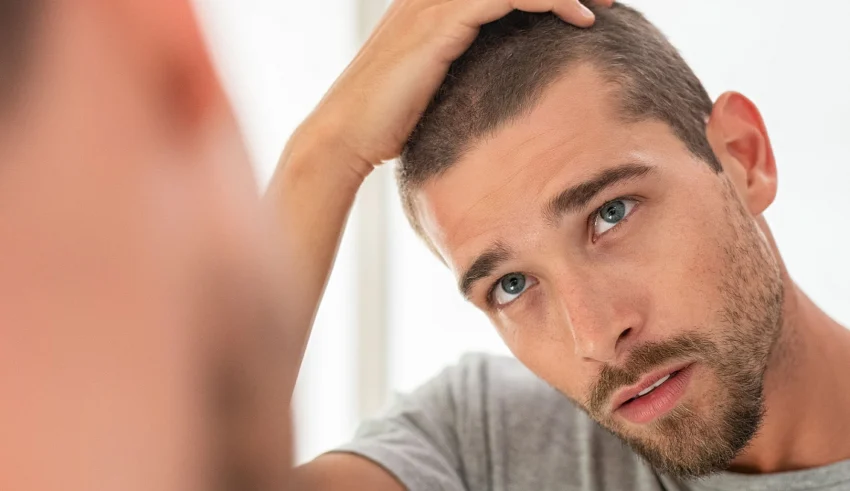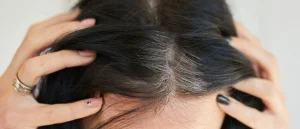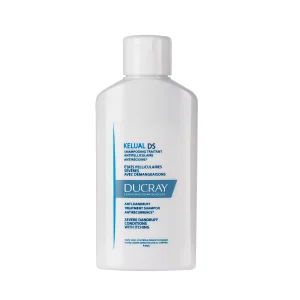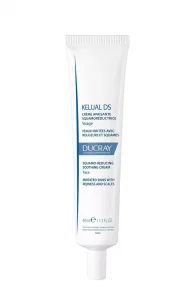
Seborrheic dermatitis is an inflammatory skin condition that often affects the scalp and causes red, scaly patches. These patches can also appear on the face and upper body. Affected areas may have a secretion of an oily substance into the hair follicles. For most people, seborrheic dermatitis is a lifelong condition that will continue to pop up and go away. If you’re wondering how to get rid of seborrheic dermatitis on the scalp, read this article from The Dermo Lab in collaboration with the dermatologist Dr. Ahmed Al Maragea.
What are the two types of seborrheic dermatitis?
Seborrheic dermatitis can cause a red, swollen, oily rash with a white or yellowish crust.
There are two types of seborrheic dermatitis:
- Cradle cap
Cradle cap is common in babies. It causes scaly patches on the baby’s scalp, which may be oily or crusty.
Cradle cap is usually not dangerous and can disappear without treatment in a few months. Some babies may have seborrheic dermatitis in the diaper area, which is usually mistaken for diaper rash. In rare cases, seborrheic dermatitis can cover the baby’s entire body, causing red, scaly patches and inflammation of the skin.
Whatever form seborrheic dermatitis takes in an infant, it tends to disappear permanently by the age of one year.
- Adult seborrheic dermatitis
Adult seborrheic dermatitis is a condition that comes and goes throughout a person’s life. The weather and stress tend to trigger flare-ups. Treatment can reduce flare-ups and provide some relief from symptoms.
What are the symptoms of seborrheic dermatitis on the scalp?
Symptoms of seborrheic dermatitis tend to worsen during cold, dry seasons or when a person is stressed.
A biopsy of the affected skin is usually performed to rule out other conditions that can cause similar symptoms.
Symptoms of seborrheic dermatitis may include:
- Dandruff, or flaking skin, on the scalp
- Red, inflamed skin
- Itchy scalp
Dr. Ahmed Al Maragea adds that symptoms also include greasy scales on the scalp with erythema.
What are the causes and risk factors of seborrheic dermatitis?
The causes of seborrheic dermatitis are unknown, but many people with this skin condition tend to have an excess of yeast in the skin of affected areas.
Certain conditions can increase the risk of developing seborrheic dermatitis. These include:
- chronic acne
- alcoholism or excessive alcohol consumption
- depression
- eating disorders
- psoriasis
- rosacea
Researchers believe that genetics and hormones may play a role in the development of seborrheic dermatitis, but they have not yet identified specific genetic mutations linked to this condition.
Stress, excess normal skin yeast and cold, dry weather are also potential triggers for seborrheic dermatitis flare-up. Dr. Ahmed Al Maragea states that having oily skin is also associated with seborrheic dermatitis.
How is seborrheic dermatitis on the scalp diagnosed?
Seborrheic dermatitis is diagnosed by its clinical appearance and behavior. Since malassezia is a normal component of the skin flora, its presence under the microscope on skin scrapings is not diagnosable.
A skin biopsy may be useful but is rarely indicated.
How to treat seborrheic dermatitis on the scalp?
The specific treatment for seborrheic dermatitis will be discussed with you based on:
- Your age, general health and medical history
- The extent of the condition
- Your tolerance to specific medications, procedures or therapies
- Your expectations for the course of the condition
- Your opinion or preference
Although the condition responds to treatment, it may recur. Treatment depends on the location of the inflammation. It is generally effective in relieving symptoms. According to Dr. Ahmed Al Maragea, seborrheic dermatitis needs a long time to disappear with treatment. He adds that the therapy consists of systemic and local treatment
Seborrheic dermatitis scalp treatment includes:
1- Medicated shampoos
These contain one of the following active ingredients: ketoconazole, ciclopirox, selenium sulfide, zinc pyrithione, coal tar and salicylic acid.
For best results, shampoos should be left on for five to ten minutes before rinsing and then rinsed off completely.
Ahead, is the best shampoo for seborrheic dermatitis that will smoothly ease your stressed scalp.
Ducray Kelual DS Treatment Shampoo
2- Steroid scalp applications
Steroid scalp applications reduce itching and should be applied daily for a few days.
3- Calcineurin inhibitors such as tacrolimus can be used as an alternative to steroids.
4- Coal tar cream can be applied to the scaling areas and removed a few hours later by shampooing.
5- Topical antifungal products
In case of irritated and scaly skin, it is recommended to use a topical treatment with antifungals (ketoconazole, ciclopiroxolamine) which removes the scales and purifies the skin on the edge of the scalp.
That’s why we recommend the following cream from Ducray:
Ducray Kelual DS Squamo-Reducing Soothing Cream
6- Combination therapy is often recommended.
Management in infants
Regular washing of the scalp with a baby shampoo or water-based cream is recommended and it can be followed by gentle brushing to remove scales.
White petrolatum may be helpful. Topical antifungals are also often prescribed, depending on the extent of the rash.
In conclusion, seborrheic dermatitis is a condition that can be easily managed with a balance of self-care and medicated treatments. Patients experience intermittent improvements and flare-ups throughout the course of their disease, which tends to be chronic.
Proper treatment of seborrheic dermatitis does not only improve the visible appearance of the rash, but also soothes the associated itching, redness, and swelling. Treatment can also prevent the development of a skin infection due to the rash.











